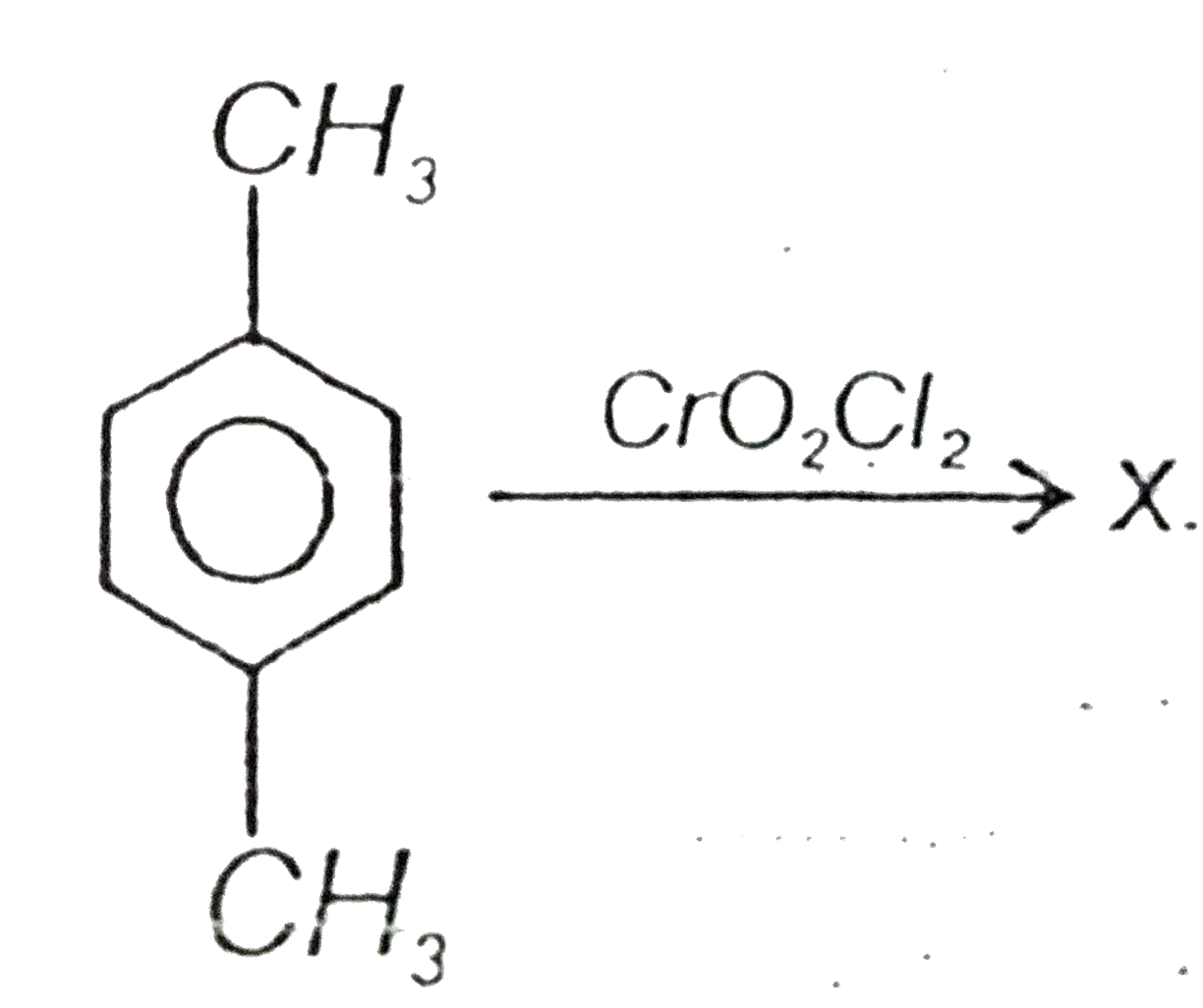Complete the missing links .
ACH3MgBr−−−−−→BH3O+−−−→C
CH3COCH3(CH3)3COMgBr,(CH3)3COH
CH3COOH,(CH3)CHOMgBr,CH3CH2OH
(CH3COO)2Ca,CH3CH2OMgBr,CH2CH∣OH−CH3
CH3COOCH3,(CH3)3COMgBr,CH3−CH∣OH−CH3
The correct Answer is:A
To solve the question, we need to identify the compounds A, B, and C based on the reaction with Grignard's reagent (CH₃MgBr) and subsequent hydrolysis.
1. Identify Compound A:
- The question states that compound A reacts with Grignard's reagent. Given the context, we can deduce that compound A is likely a type of ether.
- In this case, we can identify A as dimethyl ether (CH₃OCH₃).
2. Reaction with Grignard's Reagent:
- When dimethyl ether (A) reacts with Grignard's reagent (CH₃MgBr), the Grignard reagent acts as a nucleophile and attacks the ether.
- This reaction leads to the formation of a new compound, which we can denote as B. The reaction can be represented as follows:
CH3OCH3+CH3MgBr→CH3C(OMgBr)(CH3)
- Here, B is a magnesium alkoxide, specifically (CH₃)₂C(OMgBr).
3. Hydrolysis of Compound B:
- The next step involves the hydrolysis of compound B in the presence of water (H₃O⁺).
- During hydrolysis, the alkoxide reacts with water, leading to the formation of an alcohol. The hydrolysis can be represented as follows:
(CH3)2C(OMgBr)+H3O+→(CH3)2C(OH)+MgBrOH
- The resulting compound C is a tertiary alcohol, specifically tert-butyl alcohol (C(CH₃)₃OH).
4. Final Summary:
- Therefore, the complete reaction sequence is:
- A: Dimethyl ether (CH₃OCH₃)
- B: (CH₃)₂C(OMgBr)
- C: Tert-butyl alcohol (C(CH₃)₃OH)
Final Answer:
- A: Dimethyl ether (CH₃OCH₃)
- B: (CH₃)₂C(OMgBr)
- C: Tert-butyl alcohol (C(CH₃)₃OH)
- The question states that compound A reacts with Grignard's reagent. Given the context, we can deduce that compound A is likely a type of ether.
- In this case, we can identify A as dimethyl ether (CH₃OCH₃).
- When dimethyl ether (A) reacts with Grignard's reagent (CH₃MgBr), the Grignard reagent acts as a nucleophile and attacks the ether.
- This reaction leads to the formation of a new compound, which we can denote as B. The reaction can be represented as follows:
CH3OCH3+CH3MgBr→CH3C(OMgBr)(CH3)
- Here, B is a magnesium alkoxide, specifically (CH₃)₂C(OMgBr).
- The next step involves the hydrolysis of compound B in the presence of water (H₃O⁺).
- During hydrolysis, the alkoxide reacts with water, leading to the formation of an alcohol. The hydrolysis can be represented as follows:
(CH3)2C(OMgBr)+H3O+→(CH3)2C(OH)+MgBrOH
- The resulting compound C is a tertiary alcohol, specifically tert-butyl alcohol (C(CH₃)₃OH).
- Therefore, the complete reaction sequence is:
- A: Dimethyl ether (CH₃OCH₃)
- B: (CH₃)₂C(OMgBr)
- C: Tert-butyl alcohol (C(CH₃)₃OH)
- A: Dimethyl ether (CH₃OCH₃)
- B: (CH₃)₂C(OMgBr)
- C: Tert-butyl alcohol (C(CH₃)₃OH)
Topper's Solved these Questions
- BOOK - NCERT FINGERTPS ENGLISHCHAPTER - ALCOHOLS,PHENOLS AND ETHERSEXERCISE - HOTS7videos
ALCOHOLS,PHENOLS AND ETHERS
- BOOK - NCERT FINGERTPS ENGLISHCHAPTER - ALCOHOLS,PHENOLS AND ETHERSEXERCISE - EXEMPLAR PROBLEMS14videos
ALCOHOLS,PHENOLS AND ETHERS
- BOOK - NCERT FINGERTPS ENGLISHCHAPTER - ALDEHYDES, KETONES AND CARBOXYLIC ACIDSEXERCISE - Assertion And Reason15videos
ALDEHYDES, KETONES AND CARBOXYLIC ACIDS
Similar Questions
Knowledge Check
- Question 1 - Select One
Compounds (A) and (C ) in the following reactions are
CH3CHO(i)CH3MgBr−−−−−−−−→(ii)H2O(A)H2SO4,Δ−−−−−−→(B)Hydroboration oxidation−−−−−−−−−−−−−−→(C)AidenticalBpositional isomersCfunctional isomersDoptical isomers. - Question 2 - Select One
H−O∣∣C−O∣∣C−HCH3MgBr(excess)−−−−−−−−−−−→H⊕3O Product :
AH3C−C∣∣O−C∣∣O−HBH3−C−CH∣OH−CH∣OH−CH3CH3C−C∣∣O−C∣∣O−CH3DCH2OH∣COOH - Question 3 - Select One
Cl−O∣∣C−OEtCH3MgBr(excess)−−−−−−−−−−−→H⊕3O Product :
APh−O∣C∣Ph−PhBPh−O∣∣C−ClCPh−O∣∣C−OEtDPh−O∣∣C−Ph
Complete the following
(i) CH3−CH3∣C∣CH3−OHheat−−−→H2SO4?O3−−−−−−−→(Ozonolysis)H2,Ni−−−→?View SolutionComplete the following reactions:
(i) CH3−CH3∣C∣Cl−CH2CH3alcKOH−−−−→ΔAO3−−−−−→Zn/H2O(B+C)
(ii) CH3ICH−CH3alcKCN−−−−→A(i)SnCl2/HCl−−−−−−−−−−−−→(ii)H2O.OH.H2O2B
(iii) HCNHCl/AlCl3−−−−−−→A(i)C6H6Δ−−−−−−−−−−→(ii)(H2O)/H−B
(iv) View Solution
View SolutionComplete the following :
C2H5OHCu/573K−−−−−→XCH3MgBr−−−−−−−−→H2O/H+YView SolutionConsider the following sequence of reactions
C2H5C≡CHCH3MgBr−−−−−→A(1)HCHO−−−−−−→(2)H2O+B
The product (B) isView SolutionPh−CH=CH−CHO(i)CH3CH2MgBr−−−−−−−−−−−→(ii)H3O⊕−−−−−−→(X)Cu,Δ−−−→(Y)
View Solution

